| Volvo 850 | |
|---|---|
 1994 Volvo 850 saloon 1994 Volvo 850 saloon | |
| Overview | |
| Manufacturer | Volvo Cars |
| Production | 1991–1997 (716,903 units) |
| Model years | 1992–1997 |
| Assembly |
|
| Designer | Jan Wilsgaard (1989) |
| Body and chassis | |
| Class | Compact executive car (D) |
| Body style | |
| Layout | |
| Platform | Volvo P80 platform |
| Powertrain | |
| Engine | |
| Transmission | |
| Dimensions | |
| Wheelbase | 2,664 mm (104.9 in) |
| Length |
|
| Width | 1,760 mm (69.3 in) |
| Height |
|
| Kerb weight |
|
| Chronology | |
| Predecessor | Volvo 240 |
| Successor | Volvo S70 (Sedan)/V70 (Estate) |
The Volvo 850 is a compact executive car that was produced by the Swedish manufacturer Volvo Cars from 1991 until 1996. Designed by Jan Wilsgaard, the car was introduced in a saloon body style; an estate style was introduced in 1993.
The Volvo 850 was shown for the first time in June 1991, and the car marked a departure for Volvo, featuring multiple unprecedented features for the company; these included a transverse 5-cylinder engine driving the front wheels, a Delta-link rear axle, a side impact protection system, and a self-adjusting front seat belt mechanism.
The Volvo 850 was succeeded by the Volvo S70 and Volvo V70.
Models
Development of what would become the 800 series first began in 1978. The so-called Project Galaxy ultimately resulted in the Volvo 850, the smaller 400 series, new manufacturing technologies as well as the Volvo Modular engine and M Gearbox lines. When development had finished, Volvo had spent the highest sum in the history of the country on an industrial project in Sweden.
850
The Volvo 850 was introduced in Europe in June 1991, as a 1992 model year car. It was launched with the slogan "A dynamic car with four unique innovations" which referred to the newly developed five cylinder transverse engine, the Delta-link rear axle, the Side Impact Protection System (SIPS), and the self-adjusting seatbelt reel for the front seats. Initially, only the saloon was available, badged as 850 GLT, and came with a choice of 2.5L or 2.0L 20V engines.
In 1992, the 850 was brought to the United States as a 1993 model, becoming Volvo's first front-wheel drive (FWD) car on the U.S. market. A wide variety of Volvo 850 models were sold, with the first-generation models produced between 1993 and 1994. These included a CNG-powered Bi-Fuel model and a diesel engined 850 badged as 850 TDI. The 850 was available in both saloon and estate versions, with manual 5-speed or automatic 4-speed transmissions.
For the 850, Volvo created what it called "Delta-link semi-independent rear suspension". Volvo held a U.S. patent for rear axle bushings that compress under load, giving the Volvo 850 passive rear steering. It also has a tight turning circle, 10.2 m (33.5 ft), and is considered very maneuverable. By comparison, later large Volvos had a 11.9 m (39.0 ft) turning circle.
The estate version of the 850 went on sale in February 1993 for all markets. The 850 saloon features an interior space of 2.80 cubic metres (99 cu ft). This is slightly more than the 2.78 cubic metres (98 cu ft) of the 2004 Mercedes-Benz E-Class, even though the car is reasonably compact on the outside. This space is achieved by mounting the in-line 5-cylinder engine transversely (from the left to the right of the car) under the hood. Full power equipment was standard on all 1993 850 models, with a sunroof and built-in child booster seat in the back folding arm rest.
-
 Pre-facelift Volvo 850, notice different front bumper, airdam, and headlights (Europe)
Pre-facelift Volvo 850, notice different front bumper, airdam, and headlights (Europe)
-
 Pre-facelift Volvo 850, rear (Europe)
Pre-facelift Volvo 850, rear (Europe)
-
 Volvo 850 estate (United States)
Volvo 850 estate (United States)
-
 Volvo 850 interior
Volvo 850 interior
-
 Dashboard instrument cluster of a 1996 Volvo 850.
Dashboard instrument cluster of a 1996 Volvo 850.
-
 Button on Volvo 850 to select between economy and sport modes, as well as button to select winter traction mode.
Button on Volvo 850 to select between economy and sport modes, as well as button to select winter traction mode.
Beginning in 1994, a facelift for all subsequent 850 models was introduced; this facelift subtly altered the visual appearance of the car, featuring new front and rear bumpers, new headlights and indicators on the outside, and a new switchgear on the inside. The same year, the 850 estate was awarded the Japanese "Good Design Grand Prize" award from the Ministry of International Trade and Industry. In August 1994, the 850 Turbo was introduced for the 1994 model year as was the new 2.4L 10V engine (or 2.3L turbo), and the T5 making 222 hp (166 kW; 225 PS). The 1994 850 Turbo is able to accelerate from 0–60 mph (0–97 km/h) in 7.1 seconds. In terms of technical features, Volvo switched from 4-bolt to 5-bolt hubs, made ABS standard on all markets and introduced a new A/C system. Other options during the model run included features such as traction control, leather interior, power glass sunroof, power seats, heated seats, remote keyless entry, automatic climate control, and automatic transmission.
Beginning with their 1995 model year, Volvo introduced the SIPS-Bag on the 850; these airbags were included as standard equipment on the 1995 Turbo models, and were optional for an additional $500 on other 850 models. This made the Volvo 850 the first mass-produced car in the world to feature the side-impact airbags. The SIPS became standard equipment for all new Volvo cars beginning with the 1996 model year. In 1995, the Volvo 850 was ranked the fourth-safest vehicle on the market by the Insurance Institute for Highway Safety.
In 1996, a "Platinum" edition of the 850 Turbo was available. The exterior paint for these models came in a metallic pearl platinum-colour and had special 16 inch alloy wheels. The interior was fitted with leather seats and burled walnut accents. Only 1,400 of these were imported for the U.S. market. 1,000 of which came in the sedan variant, while the other 400 were wagons.
In 1997, the 850 Turbo was rebadged as the 850 "T-5."
850 T-5R
For 1995, the special limited edition 850 T-5R was offered, and was a commercial success, leading Volvo to produce a second run in 1996. Originally, it was to be called 850 Plus 5. The vehicle was based on the 850 Turbo, utilizing the B5234T5 engine with a special ECU (Bosch #628 in U.S and #629 in EU) that added an additional 2 psi (0.1 bar) of turbocharger boost pressure, giving the engine an extra 18 hp (13 kW; 18 PS) for a total of 243 hp (181 kW) and 250 lb⋅ft (340 N⋅m) of torque. The engine was mated to a 4-speed automatic transmission or 5-speed manual transmission, the latter of which was not available in the United States. The T-5R was renowned as a sleeper car; despite its boxy, understated appearance, it boasted a drag coefficient of 0.29 and was capable of accelerating from 0 to 60 mph (97 km/h) in 5.8 – 6.0 seconds (depending on transmission and body type). The top speed was electronically limited to 152.2 mph (244.9 km/h). The vehicle came standard with Pirelli P-Zero tyres, providing lateral grip of 0.88 g. The engine tuning was co-developed with Porsche, as was the transmission and other powertrain components. Porsche also aided in designing some of the interior, such as the Alcantara seat inserts. These cars came as standard with nearly every feature available, only a handful of options – such as heated rear seats – were available. On the North American market only two options could be chosen, a trunk-mounted Alpine 6-CD changer and no-cost 16" wheels for a smoother, more comfortable ride and driveability in snow when using all-season tires.
Also included in the 1995 T-5R package was a front bumper with a lip, rear spoiler, side skirts, polished aluminum door sills, special graphite leather and Alcantara seats, and a black interior with deep walnut wood grain accents. Both yellow and black versions came with the same black interior as the only choice. The T-5R has an additional badge to the left of the "850" on the trunk, referred to as "The Motorsport badge". The standard road wheel was the titanium-gray 5-spoke 17×7 "Titan". 1995 was the only year that the a model was badged as a "T-5R"; the following year, as Volvo recognized the vehicle's popularity, the model was renewed with the designation "850R".
The T-5R featured side airbags installed in the seat cushions. The side airbags were integrated into the rest of the Volvo model line the following year as an option, and became standard a year after that; other manufacturers soon followed suit. The car was also fitted with an early example of daytime running lamps. Also, just like the 940, it had three-point seatbelts at all five seating positions (previously, cars had only a lap belt for the center rear seat). The T-5R also used the OBDII diagnostics system, a year before OBDII was made an automotive standard.
6964 T-5Rs were produced worldwide, of which the largest market was Germany (1,433), Italy (914; 2.0 turbo), United States (876), Japan (749), Netherlands (489), UK (440), Sweden (321), Spain (185), and Canada (103).
The 1995 850 T-5R was limited in exterior paint color choices:
- Cream Yellow – 2,537 worldwide including saloon and estate. Only 346 sedans in this color were imported into the United States; wagons, only 49. Cream Yellow was marketed in the Australian market as 'Faded Yellow' to compensate for the unrelenting Australian sun. The Gothenburg engineers were aware of the 1990s paint technology, and the fact it wouldn't retain its deep luster over the course of time, and hence, the clever marketing descriptor, 'Faded Yellow' was coined.
- Stone Black – 2,516 worldwide including saloon and estate
- Olive Green metallic – 1,911 worldwide including saloon and estate
Colour distribution was limited in some countries, that is, not all countries got all three colours: Norway only received yellow, for instance.
Two white, two Aubergine and three grey T-5Rs were also produced. The white and aubergine cars were preproduction cars whereas the grey ones were produced by special demand for the Arabian market. Both aubergines, at least one grey and at least one white T-5R were still registered in Sweden as late as 2014.
-
 Volvo 850 T-5R saloon at the Volvo Museum (Europe)
Volvo 850 T-5R saloon at the Volvo Museum (Europe)
-
 Volvo 850 T-5R saloon rear (Europe)
Volvo 850 T-5R saloon rear (Europe)
-
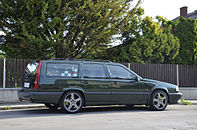 Volvo 850 T-5R estate in green (Europe)
Volvo 850 T-5R estate in green (Europe)
-
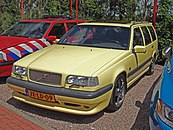 Volvo 850 Estate T-5R in yellow
Volvo 850 Estate T-5R in yellow
850 R
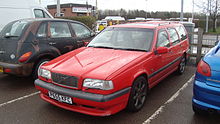
In the spring of 1996, Volvo introduced a new high-performance Volvo 850 as a replacement for the hugely successful limited edition T-5R. Volvo decided there should be no direct successor to the T-5R, but due to its success, Volvo decided to develop a new high-performance model. The new car, based on the T-5R, was called the 850 R, which again came in either saloon or sport wagon editions.
The only colours available were Bright Red, Black Stone, Dark Grey Pearl, Dark Olive Pearl, Turquoise Pearl and Polar White. In the U.S. market only Bright Red, Polar White and Black Stone were available. Cream yellow was discontinued for the 850 R. The saloon featured a newly designed rear spoiler; spoiler was now standard on the estate. The interior upgrades included bucket style heavily bolstered 'sport' front seats (Alcantara centre with leather bolsters), Alcantara door cards, 2-tone leather steering wheel, stainless steel '850' kick plates and R branded over mats. A 200w amplifier was also added to the 8-speaker audio system as was the option to have an SC-805/815 in-dash CD player (some markets).
For a limited time in 1996 only, Volvo offered a new heavy duty manual transmission designed specifically for the 850 R (excluding U.S. market), called the M59, which featured a viscous coupling limited slip differential. Furthermore, the M59 equipped cars were fitted with the B5234T4 2.3-litre 5-cylinder engine featuring a larger TD04HL-16T turbo, re-designed turbo manifold & intercooler, unique ECU with Motronic 4.3, uprated fuel pressure sensor and a heavy duty clutch. These modifications enabled the manual transmission cars to produce 250 PS (184 kW) and 350 N⋅m (258 lb⋅ft) versus 240 PS (177 kW) and 330 N⋅m (243 lb⋅ft) for the automatic transmission.
Due to encumbrances placed on engine volume by the Italian government, 850 Rs sold in Italy were based on the 2.0-litre 850 Turbo, producing 211 PS (155 kW). The transmission was the standard AW/50-42 used in all U.S. 850s, the M59 being available in other countries.
850 AWD
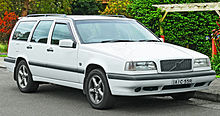
In November 1996, Volvo launched the 850 AWD. Available as a 1997 model it came only in estate configuration, featured standard all-wheel drive and was only available in certain markets. All cars were equipped with the new 2.5L turbo engine developing 193 PS (142 kW; 190 hp). The only available transmission was a 5-speed manual. Ride height was marginally increased over FWD models, a newly developed multilink rear axle with rear self-leveling suspension was standard. Visual features included front and rear mudflaps, the exhaust exiting on the right rear with the bumper being provisioned for dual outlets and specific AWD badging. The Volvo 850 was discontinued in 1997 after a newer generation became available in 1996.
Engines
| Model | Engine code | Year(s) | Fuel Delivery | Power at rpm | Torque at rpm | Displacement | 0–100 km/h (0–62 mph) | Top speed | Ref(s). |
|---|---|---|---|---|---|---|---|---|---|
| 2.0 10V | B5202FS | 1995–1997 | Siemens Fenix 5.2 | 126 PS (93 kW; 124 hp) at 6100 | 170 N⋅m (125 lb⋅ft) at 4800 | 1,984 cc (121.1 in) |
|
194 km/h (121 mph) | |
| 2.0 20V | B5204FS | 1992–1996 | Bosch LH 3.2 Jetronic | 143 PS (105 kW; 141 hp) at 6500 | 184 N⋅m (136 lb⋅ft) at 3800 | 1,984 cc (121.1 in) | 10.5s | 203 km/h (126 mph) | |
| 2.4 20V | B5244F | 1994–1997 | Bosch | 148 PS (109 kW; 146 hp) at 6500 | 197 N⋅m (145 lb⋅ft) at 3700 | 2,319 cc (141.5 in) |
|
196 km/h (122 mph) | |
| 2.5 10V | B5252S | 1994–1997 | Siemens Fenix 5.2 | 144 PS (106 kW; 142 hp) at 5400 | 206 N⋅m (152 lb⋅ft) at 3600 | 2,435 cc (148.6 in) | 10.0s | 205 km/h (127 mph) | |
| 2.5 20V | B5254S | 1991–1995 | Bosch LH 3.2 Jetronic | 170 PS (125 kW; 168 hp) at 6200 | 220 N⋅m (162 lb⋅ft) at 3300 | 2,435 cc (148.6 in) |
|
210 km/h (130 mph) | |
|
B5254T | 1996–1997 | Bosch Motronic 4.4 | 193 PS (142 kW; 190 hp) at 5100 | 270 N⋅m (199 lb⋅ft) at 1800 | 2,435 cc (148.6 in) | 7.8s | 225 km/h (140 mph) | |
| T-5 2.0 | B5204T | 1993–1997 | Bosch Motronic 4.3 | 211 PS (155 kW; 208 hp) at 5000 | 300 N⋅m (221 lb⋅ft) at 2200 | 1,984 cc (121.1 in) | 7.3s | 230 km/h (143 mph) | |
| T-5 2.3 | B5234T | 1993–1997 | Bosch Motronic 4.3 | 225 PS (165 kW; 222 hp) at 5200 | 340 N⋅m (251 lb⋅ft) at 2000 | 2,319 cc (141.5 in) | 7.2s | 240 km/h (149 mph) | |
| T-5R 2.0 | B5204T | 1995–1996 | Bosch Motronic 4.3 | 211 PS (155 kW; 208 hp) at 5400 | 300 N⋅m (221 lb⋅ft) at 1900 | 1,984 cc (121.1 in) |
|
229 km/h (142 mph) | |
| T-5R (Auto) | B5234T5 | 1995–1996 | Bosch Motronic 4.3 |
|
300 N⋅m (221 lb⋅ft) at 2000 | 2,319 cc (141.5 in) | 7.4s | 245 km/h (152 mph) | |
| T-5R (Manual) | B5234T5 | 1995–1996 | Bosch Motronic 4.3 |
|
330 N⋅m (243 lb⋅ft) at 3000 | 2,319 cc (141.5 in) | 6.9s | 245 km/h (152 mph) | |
| R (Auto) | B5234T5 | 1996–1997 | Bosch Motronic 4.3 | 240 PS (177 kW; 237 hp) at 5400 | 300 N⋅m (221 lb⋅ft) at | 2,319 cc (141.5 in) | 7.5s | 235 km/h (146 mph) | |
| R (Manual) | B5234T4 | 1996–1997 | Bosch Motronic 4.3 | 250 PS (184 kW; 247 hp) at 5400 | 350 N⋅m (258 lb⋅ft) at 2400 | 2,319 cc (141.5 in) | 6.7s | 255 km/h (158 mph) |
| Model | Engine code | Year(s) | Power | Torque at rpm | Displacement | 0–100 km/h (0–62 mph) | Top speed | Refs. |
|---|---|---|---|---|---|---|---|---|
| TDI | D5252T (MSA 15.7) | 1996–1997 | 140 PS (103 kW; 138 hp) | 290 N⋅m (214 lb⋅ft) at 1900 | 2,461 cc (150.2 in) | 9.9 s | 200 km/h (124 mph) |
Notes
- a B5254S: 1992–1995 have Bosch LH 3.2. In 1996, both Bosch LH 3.2 and Bosch Motronic 4.4 was fitted. As of 1997 only Bosch Motronic 4.4 was fitted. Please see Volvo Owners Manual Archived 2013-03-19 at the Wayback Machine and press release Archived 2012-03-13 at the Wayback Machine for the 1995 T-5R.
- b Modified 2.5L VAG TDI engine.
Motorsport
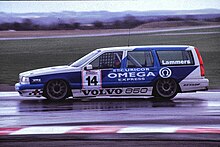
Volvo joined forces with Tom Walkinshaw Racing (TWR) in 1994 to build an 850 Estate Super Touring Car to compete in the British Touring Car Championship (BTCC). Despite much criticism, the 850 Estate performed well, with a best qualifying placing of third and a best race finish of fifth. The 850 Estates were driven by Rickard Rydell and Jan Lammers and Volvo finished eighth in the Manufacturers' standings of the 1994 championship. For 1995, TWR built a Saloon version, with the switch from Estate to Saloon being made mainly due to changes in BTCC regulations regarding aerodynamic aids which effectively ended any chance of the Estate being competitive. With Rickard Rydell and Tim Harvey driving, the 850 Saloons qualified on pole position 12 times and won six races, with Volvo placing third in the Manufacturers Championship. In 1996, an improved 850 Saloon competed in the championship with Rickard Rydell and Kelvin Burt driving, achieving five race wins. Volvo again finishing third in the Manufacturers’ Championship. Volvo also competed in the Super Touring category with the 850 across Europe and in Australia in this era.
In Australia Volvo Dealer Racing entered an 850 T-5 for Peter Brock and Tony Scott in the 1994 James Hardie 12 Hour production car race at Bathurst, finishing 25th. It entered the Australian Super Touring Championship with an estate version driven by Scott in 1995 and an 850 saloon by Brock in 1996 and Jim Richards in 1997. Two cars were entered in the 1997 Bathurst 1000.
See also
- Volvo S70, succeeding saloon model, largely a facelift version
- Volvo V70, succeeding estate model, largely a facelift version
- Volvo 440/460, compact models bearing a similar design (post-facelift)
References
- "Volvo 850 Production Statistics". www.volvoclub.org.uk. Retrieved 2017-09-24.
- Yvonne (Pur-Filur) (22 May 2018). "Funny wall decorations inside the passage, body sides of different models built at the factory through the years" (JPG) (in Swedish). Archived from the original on 2018-05-22. Retrieved 2018-05-22.
- "Volvo 850". 12 April 2017.
- "Made in the Philippines: Cars that proudly flew the flag". 12 June 2018.
- "In memoriam of Jan Wilsgaard". www.volvocars.com. Volvo Car Corporation. 25 August 2016. Archived from the original on 2018-05-31. Retrieved 2018-05-31.
- ^ "Volvo 850 Sedan". www.volvocars.com. Volvo Car Corporation. Archived from the original on 2017-11-07. Retrieved 2018-04-13.
- ^ "Volvo 850 Estate". www.volvocars.com. Volvo Car Corporation. Retrieved 2018-04-13.
- "1997 Volvo 850 owner's manual". new.volvocars.com. Volvo Car Corporation. 1996. Archived from the original on 2017-11-07. Retrieved 2017-09-24.
- "1994 Volvo 850 owner's manual". new.volvocars.com. Volvo Car Corporation. 1993. Archived from the original on 2017-04-17. Retrieved 2017-09-24.
- "1996 Volvo 850 owner's manual". www.volvocars.com. Volvo Car Corporation. 1995. Archived from the original on 2017-08-15. Retrieved 2016-09-24.
- ^ "Volvo with four world-firsts turns 20". www.media.volvocars.com. Volvo Car Corporation. 9 June 2011. Retrieved 2017-04-14.
- ^ Ekstedt et al. 2003, p. 79.
- "Volvo 850 Projekt Galaxy "Att sikta mot stjärnorna"" [Volvo 850 Project Galaxy "Aiming for the stars"] (in Swedish). Volvo AB. 7 December 2013. Archived from the original on 2021-12-21. Retrieved 2018-04-15 – via Youtube.
- Ekstedt et al. 2003, p. 80.
- ^ "The model that aimed for the stars: the Volvo 850 celebrates its 25th birthday". www.media.volvocars.com. Volvo Car Corporation. 7 June 2016. Archived from the original on 2018-04-14. Retrieved 2018-04-10.
- "Volvo History. Volvo 850 Saloon or Sedan". www.volvoclub.org.uk. Retrieved 2015-09-21.
- ^ "1990–1999: A historical review". www.media.volvocars.com. Volvo Car Corporation. 8 January 2000. Archived from the original on 2017-06-30. Retrieved 2015-09-21.
- ^ Nevin, Brad (29 April 2005). "The Spiritual Predictor of Volvo Today". Ford Communications Network. Archived from the original on 2007-11-04. Retrieved 2018-04-04.
- ^ Elsworth, Peter C. (2 October 1994). "DRIVING SMART; The First Side-Impact Air Bags: How Volvo's System Works". The New York Times. Retrieved 2017-12-20.
- Toma, Ilie (23 January 2014). "Poza istorică a zilei: Volvo 850, 1991–1996" [Historical picture of the day: Volvo 850, 1991–1996]. www.piataauto.md (in Romanian). Online Media Ltd. Archived from the original on 2018-02-06. Retrieved 2014-01-25.
- ^ "Volvo 850 GLT". Popular Mechanics. Hearst Magazines. February 1993. p. 98. ISSN 0032-4558. Retrieved 2018-05-31 – via Google Books.

- "Volvo 850 Sedan 1st Generation 1992 – 1993". www.car.info. Jonas Bonde. Retrieved 2018-04-14.
- "Volvo 850 Station Wagon 1st Generation 1993 – 1993". www.car.info. Jonas Bonde. Retrieved 2018-04-14.
- "Sales And Production Statistics 1996". Volvo Group AB. 4 February 1997. Archived from the original on 2015-11-17. Retrieved 2018-02-06.
- Fritscher, Otto (29 May 1996). "Volvo 850 TDI Kombi – Und immer unterwegs" [Volvo 850 TDI estate – And always on the move]. www.sueddeutsche.de (in German). Süddeutsche Zeitung. Retrieved 2017-09-24.
- "Volvo 850 Estate models". www.autoevolution.com. Retrieved 2018-05-31.
- "Volvo 850 models". Auto Evolution. Retrieved 2018-04-12.
- "Volvo 850 1st Generation 1992 – 1993 Specifications". Car.info. Jonas Bonde. Retrieved 2018-04-13.
- Schuon, Marshall (31 October 1993). "About Cars: From Volvo, Speed and Space". The New York Times. Retrieved 2018-04-13.
- Woodham, Jonathan (2016). A Dictionary of Modern Design (eBook). Oxford Quick Reference Online (2 ed.). n.p.: Oxford University Press. ISBN 978-0-192-51853-8 – via Google Books.
- "1993–97 Volvo 850". Consumer Guide. 28 July 2014. Retrieved 2018-04-14.
- "Second-Generation Sips-Bag protects both chest and head" (Press release). Volvo Group AB. 17 July 1998. Archived from the original on 2015-02-21. Retrieved 2017-07-07.
- USDOT (7 June 1999). "PE99-040" (PDF). static.nhtsa.gov (ODI investigation). NHTSA. pp. 2, 24. Archived (PDF) from the original on 29 January 2018. Retrieved 2018-01-29.
- Walton 1999, p. 344.
- ^ Appel, Tom (28 July 2014). "1993–97 Volvo 850". Consumer Guide Auto.
- ^ "New Cars". Popular Mechanics: 76. April 1996. ISSN 0032-4558 – via Google Books.

- "Volvo 850 Plus 5" (PDF) (Press release). Volvo Car UK Ltd. 11 April 1994. pp. 2–3. Archived (PDF) from the original on 2018-02-05. Retrieved 2018-02-06.
- "Volvo's Turbo 850 T-5R: Thor's newest lightning bolt". Volvo Cars of North America. Archived from the original on 2012-03-13. Retrieved 2014-04-04.
- Fordham, John (22 April 1995). "Motoring: The Volvo T-5R estate in 0–60 seconds by John Fordham". The Independent. Retrieved 2015-09-21.
- ^ Herrebout, Matthew (26 March 2018). "Cream Yellow 850 T-5R Volvos are very rare...it's the paint". Matthewsvolvosite.com. Retrieved 2018-04-13.
- DeMuro, Doug (June 2017). "I Always Lusted After the Volvo 850 T-5R". Autotrader. Archived from the original on 2018-04-14. Retrieved 2017-12-30.
- "Production numbers". www.volvo850t-5r.com. 7 August 2014. Archived from the original on 2018-05-31. Retrieved 2018-05-05.
- ^ Schuon, Marschall (3 March 1996). "Behind the Wheel: Volvo 850 R; A Wolf in Swedish Clothing". The New York Times. Retrieved 2018-04-12.
- "Volvo 850 R Car Review". www.mynrma.com.au. 1 October 1996. Archived from the original on 2016-12-20. Retrieved 2017-09-24.
- ^ Jan-Henrik Muche (11 January 2013). "Volvo 850 AWD – Schwedische Familienkutsche" [Volvo 850 AWD – swedish family car]. www.autobild.de (in German). Auto Bild. Retrieved 2015-09-21.
- ^ "Volvo 850 AWD 1996 U.S. Brochure" (PDF). Volvo Car Corporation. 1996. Retrieved 2018-04-13.
- "850 AWD" (PDF). Volvo Car Corporation. p. 3. Retrieved 2017-12-21.
- "Volvo 850". Autocar & Motor. 194. Haymarket, Pub., Limited: 58–59. 1992. ISSN 1355-8293.
- "Volvo 850 – Versions and Engines by year (1992 to 1997)". 2014-07-13. Retrieved 2018-05-27.
- ^ "1996 Volvo 850". new.volvocars.com. Volvo Car Corporation. 1995. Archived from the original on 2013-03-19. Retrieved 2015-09-21.
- ^ "Volvo Preisliste Modelljahr 1997" [Volvo price list model year 1997] (PDF). www.motor-talk.de (in German). Volvo Deutschland GmbH. Retrieved 2018-04-13.
- "Volvo S70 Technical Specifications" (PDF). www.volvoclub.org.uk. 1997. p. 3. Retrieved 2018-04-13.
- "Prijslijste Volvo 850 T-5R" [Price list Volvo 850 T-5R] (JPG) (in Dutch). Archived from the original on 2018-04-14. Retrieved 2018-04-13.
- "850 R". www.r-modelle.info (in German). Archived from the original on 2016-11-05. Retrieved 2017-10-25.
- "Trouble-Shooting – Volvo" (PDF). Autodiagnos. p. 44. Archived (PDF) from the original on 2018-04-14. Retrieved 2018-04-12.
- "'97 Imports". Car and Driver. 42. Ziff-Davis Publishing Company: 30, 69, 121. 1996. ISSN 0008-6002.
Works cited
- Ekstedt, Eskil; Lundin, Rolf A.; Söderholm, Anders; Wirdenius, Hans (2003). Neo-Industrial Organising: Renewal by Action and Knowledge Formation in a Project-intensive Economy. New York: Routledge. ISBN 978-1-134-63025-7.
- Walton, Mary (1999). Car: A Drama of the American Workplace. New York: W. W. Norton & Company. ISBN 978-0-393-31861-6.
External links
| « previous — Volvo Cars road car timeline, 1975–2019 — next » | |||||||||||||||||||||||||||||||||||||||||||||||||||||||||||||||||||||||||||||||||||||||||||||||||||||||||||||||||||||||||||||||||||||||||||||||||||||||||||||||||||||||||||||||||||||||||||||||||||||||||||||||||||||||||||||||||||||||||||||||||||||||||||||||||||||||||||||||||||||||||||||||||||||||||||||||||||||||||||||||||||||||||||||||||||||||||||||||||||||||||||||||||||||||||||||||||||||||||||||||||||||||||||||||||||||||||||||||||||||||||||||||||||||||||||||||||||||||||||||||||||||||||||||||||||||||||||||||||||||||||||||||||||||||||||||||||||||||||||||||||||||||||||||||||||||||||||||||||||||||||||||||||||||||||||||||||||||||||||||||||||||||||||||||||||||||||||||||||||||||||||||||||||||||||||||||||||||||||||||||||||||||||||||||||||||||||||||||||||||||||||||||||||||||||||||||||||||||||||||||||||||||||||||||||||||||||||||||||||
|---|---|---|---|---|---|---|---|---|---|---|---|---|---|---|---|---|---|---|---|---|---|---|---|---|---|---|---|---|---|---|---|---|---|---|---|---|---|---|---|---|---|---|---|---|---|---|---|---|---|---|---|---|---|---|---|---|---|---|---|---|---|---|---|---|---|---|---|---|---|---|---|---|---|---|---|---|---|---|---|---|---|---|---|---|---|---|---|---|---|---|---|---|---|---|---|---|---|---|---|---|---|---|---|---|---|---|---|---|---|---|---|---|---|---|---|---|---|---|---|---|---|---|---|---|---|---|---|---|---|---|---|---|---|---|---|---|---|---|---|---|---|---|---|---|---|---|---|---|---|---|---|---|---|---|---|---|---|---|---|---|---|---|---|---|---|---|---|---|---|---|---|---|---|---|---|---|---|---|---|---|---|---|---|---|---|---|---|---|---|---|---|---|---|---|---|---|---|---|---|---|---|---|---|---|---|---|---|---|---|---|---|---|---|---|---|---|---|---|---|---|---|---|---|---|---|---|---|---|---|---|---|---|---|---|---|---|---|---|---|---|---|---|---|---|---|---|---|---|---|---|---|---|---|---|---|---|---|---|---|---|---|---|---|---|---|---|---|---|---|---|---|---|---|---|---|---|---|---|---|---|---|---|---|---|---|---|---|---|---|---|---|---|---|---|---|---|---|---|---|---|---|---|---|---|---|---|---|---|---|---|---|---|---|---|---|---|---|---|---|---|---|---|---|---|---|---|---|---|---|---|---|---|---|---|---|---|---|---|---|---|---|---|---|---|---|---|---|---|---|---|---|---|---|---|---|---|---|---|---|---|---|---|---|---|---|---|---|---|---|---|---|---|---|---|---|---|---|---|---|---|---|---|---|---|---|---|---|---|---|---|---|---|---|---|---|---|---|---|---|---|---|---|---|---|---|---|---|---|---|---|---|---|---|---|---|---|---|---|---|---|---|---|---|---|---|---|---|---|---|---|---|---|---|---|---|---|---|---|---|---|---|---|---|---|---|---|---|---|---|---|---|---|---|---|---|---|---|---|---|---|---|---|---|---|---|---|---|---|---|---|---|---|---|---|---|---|---|---|---|---|---|---|---|---|---|---|---|---|---|---|---|---|---|---|---|---|---|---|---|---|---|---|---|---|---|---|---|---|---|---|---|---|---|---|---|---|---|---|---|---|---|---|---|---|---|---|---|---|---|---|---|---|---|---|---|---|---|---|---|---|---|---|---|---|---|---|---|---|---|---|---|---|---|---|---|---|---|---|---|---|---|---|---|---|---|---|---|---|---|---|---|---|---|---|---|---|---|---|---|---|---|---|---|---|---|---|---|---|---|---|---|---|---|---|---|---|---|---|---|---|---|---|---|---|---|---|---|---|---|---|---|---|---|---|---|---|---|---|---|---|---|---|---|---|---|---|---|---|---|---|---|---|---|---|---|---|---|---|---|---|---|---|---|---|---|---|---|---|---|---|---|---|---|---|---|---|---|---|---|---|---|---|---|---|---|---|---|---|---|---|---|---|---|---|---|---|---|---|---|---|---|---|---|---|---|---|---|---|---|---|---|---|---|---|---|---|---|---|---|---|---|---|---|---|---|---|---|---|---|---|---|---|---|---|---|---|---|---|---|---|---|---|---|---|---|---|---|---|---|---|---|---|---|---|---|---|---|---|---|---|---|---|---|---|---|---|---|---|---|---|---|---|---|---|---|---|---|---|---|---|---|---|---|---|---|---|---|---|---|---|---|---|---|---|---|---|---|---|---|---|---|---|---|---|---|---|---|---|---|---|---|---|---|---|---|---|---|---|---|---|---|---|---|---|---|---|---|---|---|---|---|---|---|---|---|---|---|---|---|---|---|---|---|---|---|---|---|---|---|---|---|---|---|---|---|
| |||||||||||||||||||||||||||||||||||||||||||||||||||||||||||||||||||||||||||||||||||||||||||||||||||||||||||||||||||||||||||||||||||||||||||||||||||||||||||||||||||||||||||||||||||||||||||||||||||||||||||||||||||||||||||||||||||||||||||||||||||||||||||||||||||||||||||||||||||||||||||||||||||||||||||||||||||||||||||||||||||||||||||||||||||||||||||||||||||||||||||||||||||||||||||||||||||||||||||||||||||||||||||||||||||||||||||||||||||||||||||||||||||||||||||||||||||||||||||||||||||||||||||||||||||||||||||||||||||||||||||||||||||||||||||||||||||||||||||||||||||||||||||||||||||||||||||||||||||||||||||||||||||||||||||||||||||||||||||||||||||||||||||||||||||||||||||||||||||||||||||||||||||||||||||||||||||||||||||||||||||||||||||||||||||||||||||||||||||||||||||||||||||||||||||||||||||||||||||||||||||||||||||||||||||||||||||||||||||

